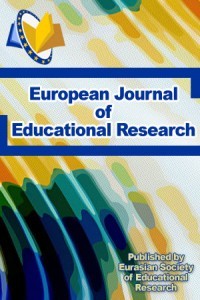Using Blogs to Improve Elementary School Students’ Environmental Literacy in Science Class
Using Blogs to Improve Elementary School Students’ Environmental Literacy in Science Class
___
- Blau, I., Mor, N., & Neuthal, T. (2009). Open the windows of communication: Promoting interpersonal and group interactions using blogs in higher education. Interdisciplinary Journal of E-Learning and Learning Objects, 5, 233–246.
- Churchill, D. (2009). Educational applications of Web 2.0: Using blogs to support teaching and learning. British Journal of Educational Technology, 40(1), 179-183.
- Clair, R. S., (2003). Words for the World: Creating Critical Environmental Literacy for Adults. New Directions for Adult and Continuing Education, 99, 69-78.
- Dabbagh, N., &Kitsantas, A. (2012). Personal Learning Environments, social media, and self-regulated learning: A natural formula for connecting formal and informal learning. The Internet and Higher Education, 15(1), 3-8.
- Daudi, S.S. and Heimlich, J.E., (1997). Environmental Literacy: What Does It Really Mean?. EETAP Resource Library, http://eelink.net/eetap/info23.pdf
- DeAndrea, D. C., Ellison, N. B., LaRose, R., Steinfield, C., & Fiore, A. (2012). Serious social media: On the use of social media for improving students' adjustment to college. The Internet and Higher Education, 15(1), 15-23.
- Deng, L., & Yuen, A. H. (2011). Towards a framework for educational affordances of blogs. Computers & Education, 56(2), 441-451.
- Disinger, J.F. and Roth, C.E., (1992). Environmental Literacy. http://www.eric.ed.gov/ERICDocs/data/ericdocs2sql/content_storage_01/00000 19b/80/12/f4/a7.pdf, ErisimTarihi 03.04.2013
- Gruzd, A., Staves, K., & Wilk, A. (2011).Tenure and promotion in the age of online social media. Proceedings of the American Society for Information Science and Technology, 48(1), 1–9. http://dx.doi.org/10.1002/meet.2011.14504801154.
- Hernandez, R.Y., (2005). An Assessment of The Environmental Literacy of Opinion Leaders in Eugena, Oregon. MS Thesis, University of Oregon.
- Istanbullu, R.A. (2008).Investigation of environmental literacy of sixth grades at a private school. Unpublished Master Thesis, ODTU, Ankara.
- Kaplan, A. M., & Haenlein, M. (2010). Users of the world, unite! The challenges and opportunities of social media. Business Horizons, 53(1), 59–68. http://dx.doi.org/ 10.1016/j.bushor.2009.09.003.
- Kisoglu, M. (2009).Ogrencimerkezliogretiminogretmenadaylarinincevreokuryazarligiduzeyineetkisininarastirilmasi. (Yayinlanmamis Doktora Tezi). Ataturk Universitesi, Erzurum.
- Minocha, S., &Kerawalla, L. (2011).University students' self-motivated blogging and development of study skills and research skills. In M. J. W. Lee, & C. McLoughlin (Eds.), Web 2.0-based e-Learning: Applying social informatics for tertiary teaching (pp. 149–179). Hershey, PA: IGI Global.
- Morrone, M., Mancl, K. and Carr, K., (2001). Development of A Metric To Test Group Differences in Ecological Knowledge As One Component of Environmental Literacy. The Journal of Environmental Education, 32(4), 33-42.
- Moseley, C., (2000). Teaching for Environmental Literacy. The Clearing House, 74(1), 23-24.
- MSU-WATER (2001-2006). Social Assessment: Stakeholder Attitudes, Beliefs, and Uses of Water Resources, co-PI M.Kaplowitz and S. Witter Vice President of Finance and Operations, Michigan State University.
- National Environmental Education Advisory Council (NEEAC), (1996).Report Assessing Environmental Education in the United States and the Implementation of the National Environmental Education Act of 1990. http://www.eric.ed.gov/ERICWebPortal/contentdelivery/servlet/ERICServlet?ac cno=ED403146, ErisimTarihi 23.03.2013
- Orr, D.W. (1990). Environmental Education and Ecological Literacy. The Education Digest, 55(9), 49-53.
- Okesli, T., F. (2008).Relationship Between Primary School Students’ Environmental Literacy and Selected Variables in Bodrum. (Unpublished Master Thesis), ODTU, Ankara
- Ravenscroft, A., Warburton, S., Hatzipanagos, S., & Conole, G. (2012). Designing and evaluating social media for learning: shaping social networking into social learning?. Journal of Computer Assisted Learning, 28(3), 177-182.
- Roth, C.E., (1968). Curriculum Overwiev for Developing Environmentally Literate Citizens. http://www.eric.ed.gov/ERICDocs/data/ericdocs2sql/content_storage_01/0000019b/80/32/38/8c.pdf
- Roth, C.E., (1992). Environmental Literacy: Its Roots, Evolution and Directions in the 1990s. http://www.eric.ed.gov/ERICDocs/data/ericdocs2sql/content_storage_01/0000019b/80/24/44/47.pdf
- Teksoz, G., Sahin, E. VeErtepinar, H., (2010), Cevre okur yazarligi, ogretmen adaylari ve surdurulebilir bir gelecek. Hacettepe Universitesi Egitim Fakultesi Dergisi, 39, 307-320, Ankara.
- Tikka, P. M., Kuitunen T. M., &Tynys M. S. (2000).Effects of educational background on students’ attitudes, activity levels, and knowledge concerning environment.The Journal of Environmental Education, 31, 12-9.
- Weiser, B.G., (2001).The Envirothon and Its Effects on Students’ Environmental Literacy. A Doctoral Dissertion, Faculty of The College of Education, University of Houston.
- Wright, J.M. (2006). The comparative Effect of Constructivist Versus Traditional Teaching Methods on Environmental Literacy of Post-Secondary Non-Science Majors. A Doctoral Dissertion, Graduate School of University of Nevada
- ISSN: 2165-8714
- Başlangıç: 2012
- Yayıncı: Eurasian Society of Educational Research
Using Blogs to Improve Elementary School Students’ Environmental Literacy in Science Class
Fatih SALTAN, Omer Faruk DİVARCİ
Effect of Pedagogical Formation Program on Pre-Service History Teachers’ Perceived Self-Efficacy
Nuri BALTA, Mohammad Hamza AWEDH
Melissa A. ADELMAN, Miguel SZEKELY
The “MelArete” Project: Educating children to the Ethics of Virtue and of Care
